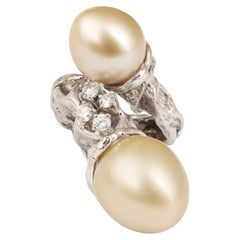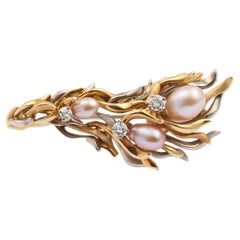Gilbert Albert On Sale
Recent Sales
Vintage 1970s Swiss Modern Cocktail Rings
Diamond, Pearl, 18k Gold, White Gold
Vintage 1970s Swiss Modern Brooches
Diamond, Pearl, Yellow Gold
Vintage 1970s Swiss Artist Cocktail Rings
Pearl, Turquoise, 18k Gold
Late 20th Century Swiss Modernist Cocktail Rings
Amethyst, Carnelian, Diamond, Multi-gemstone, Onyx, Quartz, Rhodolite, C...
Vintage 1980s Swiss Contemporary Cocktail Rings
Agate, Amethyst, Carnelian, Diamond, Hematite, Yellow Gold
20th Century Swiss Artisan Wrist Watches
18k Gold, Yellow Gold
Gilbert Albert for sale on 1stDibs
When it came to creating elegant jewelry out of unusual materials, Gilbert Albert was a master alchemist. Not only was he the first known jeweler to set meteorite fragments in fine jewelry, but he also crafted works from more earthly components such as sea-urchin skeletons, shark teeth, peacock feathers and fulgurites, which he placed in tubes of glass made from sand that had been struck by lightning.
Born in Geneva, Switzerland, in 1930, Albert began training in jewelry design at the age of 15 while attending the city’s School of Industrial Arts. There, he became influenced by European abstract artists such as Piet Mondrian and Constantin Brâncusi. A decade later, luxury watchmaker Patek Philippe spotted Albert’s talents, and for the next seven years, he worked at the company as a designer, developing Patek’s signature asymmetrical timepieces.
In 1962, Albert opened his first atelier and pioneered a method for incorporating unconventional natural materials into his jewelry. Driven by a lifelong love of nature, Albert combined petrified plants, furs, feathers, dinosaur fossils and beetle exoskeletons with traditional precious metals and gemstones to make curious rings, brooches, bracelets and watches. Among his most well-known pieces are his sculptural gold clip-on earrings, pendant necklaces and interchangeable cocktail rings with removable beads.
Throughout his career, Albert’s creations have been exhibited at shows and fairs in Prague, Paris, London, Milan, Copenhagen, Antwerp, Brussels, New York, Vienna, Salzburg, Tokyo, Osaka, São Paulo, Lisbon and Dubai. He was also the first living artist since 1917 invited to display work at the Kremlin, in Moscow.
In addition to receiving numerous accolades for his jewelry designs — he won the Diamonds International Award 10 times — Albert has been recognized for his talents as an artist. In 1999, the Swiss government hired him to design the “Mass” of the Republic of Geneva. He also received the Ramsar Wetlands Conservation Award, and Geneva’s International Museum of the Reformation has one of his sculptures on permanent display.
Even after Albert’s death, in 2019, his artisanal jewelry remains highly coveted among collectors.
On 1stDibs, discover a range of Gilbert Albert rings, necklaces and earrings.
Why Gold Shines in Jewelry Craftsmanship
Gold is the feel-good metal, the serotonin of jewelry. Wear vintage and antique gold necklaces, watches, gold bracelets or gold rings and you feel happy, you feel dressed, you feel, well, yourself.
Gold, especially yellow gold, with its rich patina and ancient pedigree going back thousands of years, is the steady standby, the well-mannered metal of choice. Any discussion of this lustrous metal comes down to a basic truth: Gold is elementary, my dear. Gold jewelry that couples the mystique of the metal with superb design and craftsmanship achieves the status of an enduring classic. Many luxury houses have given us some of our most treasured and lasting examples of gold jewelry over the years.
Since its founding, in 1837, Tiffany & Co. has built its reputation on its company jewelry as well as its coterie of boutique designers, which has included Jean Schlumberger, Donald Claflin, Angela Cummings and Elsa Peretti. There are numerous gold Tiffany classics worth citing. Some are accented with gemstones, but all stand out for their design and the workmanship displayed.
For the woman who prefers a minimalist look, the Tiffany & Co. twist bangle (thin, slightly ovoid) is stylishly simple. For Cummings devotees, signature pieces feature hard stone inlay, such as her pairs of gold ear clips inlaid with black jade (a play on the classic Chanel black and tan), or bangles whose design recalls ocean waves, with undulating lines of lapis lazuli and mother-of-pearl. And just about any design by the great Jean Schlumberger is by definition a classic.
Even had he eschewed stones and diamonds, Southern-born David Webb would be hailed for the vast arsenal of heavy gold jewelry he designed. Gold, usually hammered or textured in some manner, defines great David Webb jewelry. The self-taught jeweler made very au courant pieces while drawing inspiration from ancient and out-of-the-way sources — East meets West in the commanding gold necklaces made by Webb in the early 1970s. The same could be said for his endlessly varied gold cuffs.
In Europe, many houses have given us gold jewelry that sets the highest standard for excellence, pieces that were highly sought after when they were made and continue to be so.
Numerous designs from Cartier are homages to gold. There are the classic Trinity rings, necklaces and bracelets — trifectas of yellow, white and rose gold. As a testament to the power of love, consider the endurance of the Cartier Love bracelet.
Aldo Cipullo, Cartier’s top in-house designer from the late 1960s into the early ’70s, made history in 1969 with the Love bracelet. Cipullo frequently said that the Love bracelet was born of a sleepless night contemplating a love affair gone wrong and his realization that “the only remnants he possessed of the romance were memories.” He distilled the urge to keep a loved one close into a slim 18-karat gold bangle.
BVLGARI and its coin jewelry, gemme nummarie, hit the jackpot when the line launched in the 1960s. The line has been perennially popular. BVLGARI coin jewelry features ancient Greek and Roman coins embedded in striking gold mounts, usually hung on thick link necklaces of varying lengths. In the 1970s, BVLGARI introduced the Tubogas line, most often made in yellow gold. The Tubogas watches are classics, and then there is the Serpenti, the house's outstanding snake-themed watches and bracelets.
A collection called Monete that incorporated the gold coins is one of several iconic BVLGARI lines that debuted in the 1970s and ’80s, catering to a new generation of empowered women. Just as designers like Halston and Yves Saint Laurent were popularizing fuss-free ready-to-wear fashion for women on the go, BVLGARI offered jewels to be lived in.
Since Van Cleef & Arpels opened its Place Vendôme doors in 1906, collection after collection of jewelry classics have enchanted the public. As predominantly expressed in a honeycomb of gold, there is the Ludo watch and accessories, circa the 1920s, and the golden Zip necklace, 1951, whose ingenious transformation of the traditional zipper was originally proposed by the Duchess of Windsor. Van Cleef's Alhambra, with its Moroccan motif, was introduced in 1968 and from the start its popularity pivoted on royalty and celebrity status. It remains one of VCA’s most popular and collected styles.
Mention must be made of Buccellati, whose name is synonymous with gold so finely spun that it suggests tapestry. The house’s many gold bracelets, typically embellished with a few or many diamonds, signified taste and distinction and are always in favor on the secondary market. Other important mid-20th-century houses known for their gold-themed jewelry include Hermès and Ilias Lalaounis.
Find a stunning collection of vintage and antique gold jewelry on 1stDibs.

